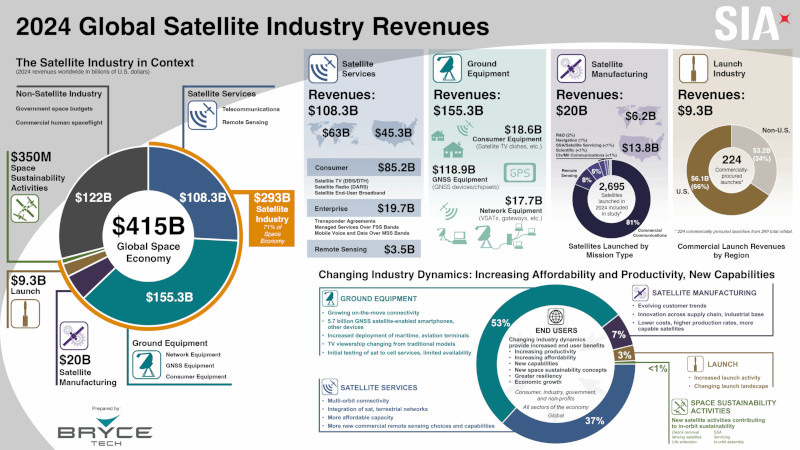The FAA has released its Final Tiered Environmental Assessment authorizing SpaceX to conduct as many as 25 Starship launches per year from Starbase in Boca Chica.
The Revised Final EA evaluates two alternatives in detail: the Proposed Action and the No Action Alternative.
The Proposed Action alternative would modify SpaceX’s existing vehicle operator license. It would authorize the company's proposal to increase the cadence of the Starship/Super Heavy launch program at the Boca Chica vertical launch area (VLA) to up to 25 annual launches, and 50 total annual landings (25 of the Starship and 25 of the Super Heavy) and make vehicle and operational upgrades. Up to three of the 25 launches would occur during nighttime hours from the VLA.
Landings at the VLA would only take place during the daytime, with up to 22 Starship and 22 Super Heavy landings at the VLA.
-0-
The global satellite communications (SATCOM) market is expected to reach a size of approximately $75 billion by the end of 2033. According to a report from Orion Market Research, that translates to a Compound Annual Growth Rate (CAGR) of 12.8 percent through the period.
The satellite communications market is experiencing rapid growth, due to increasing demand for broadband connectivity, especially in remote and underserved regions.
The market is driven by the growing demand for reliable internet connectivity in remote and rural areas, where traditional broadband infrastructure is limited. The rise of low Earth orbit (LEO) satellite constellations, such as those from SpaceX's Starlink and Amazon's Project Kuiper, is significantly enhancing global coverage and data speeds. The increasing need for secure and efficient communication in defense, government, and military sectors is another major growth factor. Additionally, the global adoption of Internet of Things devices, 5G networks, and smart technologies is creating a surge in demand for satellite-based communication.
-0-
The Satellite Industry Association (SIA) this week announced the release of its 28th annual State of the Satellite Industry Report (SSIR), a global summary of the commercial satellite industry. During 2024, the industry continued to grow at an unprecedented rate as a record number of 259 launches deployed an historic 21-hundred 72 tons, and 2,695 satellites into Earth orbit. At the end of 2024, a total of 11,539 satellites were operating in Earth orbit compared with just 3,371 in 2020.
After the release of the report, I delved into some of the details with Satellite Industry Association president Tom Stroup, starting with some of report's the key findings.
Tom Stroup, SIA
Yeah, I think that, you know, one of the key takeaways is that the industry continues to grow. And of course, we've seen different growth rates in the various sectors of the industry. But the manufacturing sector grew 17 percent last year. The launch sector grew 30% by revenue. And then within satellite services, we've seen satellite broadband and remote sensing continuing to grow very nicely. So I think that those are a couple of the key takeaways.
But also... you know the revenues only tell a portion of what's happening within the industry because there's so much innovation that's taking place and that's one of the things that we you know i've tried to highlight in the report that um you know while the and the industry is showing a tremendous amount of increase in terms of the number of satellites and growth within some of the different sectors that i just mentioned um you know it's it's really driven by the innovation that that has occurred across each of the different sectors of the industry so I think that those are some of the key takeaways, Tom.
Ex Terra Media
When you talk about the satellite part of the industry as a whole,
how much does the satellite industry contribute to the overall space 2.0 economy?
Tom Stroup, SIA
Yeah, so the industry generates $293 billion as of the end of last year. That was 71% of the global space economy. So it's far and away the largest component of the global space economy. And why do you think that growth is occurring?
Ex Terra Media
What's driving it?
Tom Stroup, SIA
I think there are two main drivers. I mean, one is demand. And, you know, you can envision just a continuous demand for broadband services as an example.
But of course, satellite is unique in terms of many of the capabilities with a ubiquitous coverage, the ability to provide service to the airline industry the maritime industry but the demand for continuous connectivity is certainly one of the the major drivers and the other is just the continued decrease in the cost of launch the increase in launch availability the decrease in cost of manufacturing satellites access to antenna technology that had not existed before.
Of course, the government, especially the U.S. government, continues to be one of the major customers of the industry. And in some cases, that's utilization of satellite operators. And in other cases, it's buying technology satellites for their own use. But there continues to be high demand, whether it's for remote sensing services, or communications by the U.S. military as well.
So those are just some of the major drivers. But I would say it starts with the fact that there's a huge demand for the services that the industry provides.
Ex Terra Media
One of the things that we often talk about is why does the general public care? Why is this important to somebody who's not involved in the space industry?
Tom Stroup, SIA
They use satellites every day, whether they think about it or not. And I'll start with the position navigation and timing capability in GPS satellites. So whether you're using a navigation system, or not the timing of mobile phone systems the timing of the internet are all based off of those satellites the next is people typically will gather some type of weather information that is gathered via satellites and well over half of the data that is gathered for climate monitoring it can only be done via satellite so whether you're using an app that such as for a shared driving service or you know many of the other apps that are dependent upon location capability or you're using it for broadband or emergency communications and then of course you don't think about it until there's an emergency when you've lost access to your cellular system but emergency personnel are very dependent upon the capabilities of the satellite industry One other one that people don't really think about is that most transactions at gas stations are conducted. You're using a credit card to be able to pay for your gas. It's actually connected via satellite system.
Ex Terra Media
Does it matter that people don't understand? And how important is that to the satellite industry that people begin to become more aware of the role that satellites play in their lives?
Tom Stroup, SIA
You know, I think it's important for policymakers to understand it because there are decisions that are made for things like access to spectrum. You know, so I think that it's important that policymakers understand. Certainly, we'd like all consumers to understand the capabilities of the industry. Many of those who have satellite television or satellite radio services, of course, understand that it's coming from satellites. But, you know, certainly we'd like everybody to appreciate the capabilities of the industry.
Produced by BryceTech, the 2025 State of the Satellite Industry Report derives from proprietary surveys of satellite companies, in-depth public information, and independent analysis, combined to assess the performance of sectors including satellite services, manufacturing, ground equipment and launch services.
-0-
Coming up, Redwire reports its first quarter results, and conductiing scientific experiments in microgravity. But right now, why not take a minute to become a paid subscriber to The Journal of Space Commerce. Whether you’re a space professional or enthusiast, paid subscribers have first access to premium articles and podcasts focused on the new space economy. Just visit www.exterrajsc.com on Substack, and help keep The Journal of Space Commerce independent as we chronicle, cajole and, when necessary, critique the commercial space industry.
-0-
Redwire Corporation has announced its first quarter 2025 results, showing an increase in bookings, but a decrease in revenues and a higher net loss over the same period in 2024.
Revenues for the first quarter of 2025 decreased 30.1% to $61.4 million, as compared to $87.8 million for the first quarter of 2024.
Net Loss for the first quarter of 2025 decreased by $5.1 million to -$2.9 million, as compared to -$8.1 million for the first quarter of 2024.
However, bookings increased significantly compared to Q4 2024, according to Peter Cannito, Chairman and Chief Executive Officer of Redwire. In an earnings call open to investors and the media, Cannito said that so far, tariffs imposed by the Trump administration have not had an effect on the company.
"We have yet to see notable widespread price increases, or shocks, due to tariffs. We are addressing one-off cases with suppliers, however we currently do not expect any material financial impact,” Cannito said. “Redwire will continue to monitor potential impacts closely as we manage our business through this dynamic environment. In some instances, we believe that the current trade environment may lead to both increasing investment in U.S. manufacturing, and in European space and defense budgets that could benefity Redwire's significant manufacturing presence in both regions."
Redwire CFO Jonathan Baliff said that he remains optimistic about the rest of the year, as the company is entering the second quarter ready to close on its acquisition of Edge Autonomy, and to capitalize on market trends in space and defense tech.
"We acknowledge that there is volatility with the rest of 2025,” Baliff said. “However, our previous combined forecast was meant to be conservative, and as of today, we believe we are still on track to end 2025 within our previously provided ranges. Therefore, we are reaffirming our combined forecast at this time."
That forecast is for full year revenues of $535 million to $605 million and Adjusted EBITDA of $70 million to $105 million with positive Free Cash Flow.
-0-
The Varda Space Industries W-3 capsule landed at the Southern Lauch Koonibba Test Range in Australia Wednesday afternoon local time. W-3 is Varda's third successful mission and comes just 11 weeks after the previous successful mission.
W-3 carried an advanced inertial measurement unit developed in collaboration with the U.S. Air Force and Innovative Scientific Solutions Incorporated (ISSI). The Prometheus program, a partnership between Varda and the U.S. Air Force, addresses a national security need to accelerate the ability to conduct novel science and technology experiments in the extreme reentry environment through a low-cost, high cadence flight testbed.
Through regular, reliable launch and return, Varda aims to continue to increase cadence and offer a novel, low-cost approach to iterative hypersonic science and technology experimentation.
-0-
The ISS National Laboratory is a research and development hub aboard the International Space Station (ISS), managed by a non-profit organization, the Center for the Advancement of Science in Space (CASIS), under a cooperative agreement with NASA. They provide access to the unique microgravity environment of low Earth orbit for scientific experiments, medical research, and technological innovation.
One of the key services provided by the ISS National Lab is facilitating collaboration between private companies, academic institutions, and government agencies to conduct experiments in space. It also supports studies on human biology, materials science, and advanced manufacturing, provides training, STEM programs, and workforce development initiatives for students and professionals, and helps translate space-based research into Earth-based applications.
On the latest edition of The Ex Terra Podcast, I talked with Phillip Irace, a Program Director for the ISS National Lab. He said that the microgravity environment makes a significant difference in conducting scientific experiments.
(SOT) "We go to space not for fun but because you can do these cool things," Irace said. "On the material science side, you can synthesize or process materials that have much more uniform microstructures and significantly reduce defects. You can even create entirely new structures or materials. On Earth, when you produce a material, any difference in temperature or density of the melt leads to things like sedimentation, stratification, mixing, and ultimately, these things lead to non-uniformities and defects that reduce a material's performance. So in microgravity, where these forces are eliminated, it opens up a lot of opportunity. In addition, in microgravity you have forces like surface tension and capillary forces that are not important on Earth, but when you get into microgravity, they're dominant. And you can take advantage of that to do cool things like containerless processing using spherical drops and fluidic templating. Then on the regenerative medicine side, the space environment has been shown to accelerate aging. So that's a huge advantage for studies in that area. Earlier I mentioned 3-D printing of organs and heart tissue. We also have a lot of protein crystalization research going on to identify viable drug candidates. Overall, I'd say that in microgravity, processes tend to be much slower and diffusion controlled, and this results in much higher quality final products, and that covers a wide range of applications."
The ISS National Lab has several programs that assist companies of all sizes get their experiments onto the station. Irace says companies can contact them at inquiries@issnationallab.org to get more information.
And those are some of the top stories we covered for you on The Journal of Space Commerce this week. You can get daily updates on space commerce by subscribing to The Journal of Space Commerce on Substack at www.exterrajsc.com. And please consider becoming a paid subscriber. Whether you’re a space professional or enthusiast, paid subscribers have first access to premium articles and podcasts focused on the new space economy. Just visit www.exterrajsc.com and help keep The Journal of Space Commerce independent as we chronicle, cajole and, when necessary, critique the commercial space industry.
-0-
You Might Have Missed
Unlocking Scalable Edge Computing with On-Demand Orbital Energy
Proba-3 Achieves Precise Formation Flying
RESILIENCE Lunar Lander Injected into Lunar Orbit


















